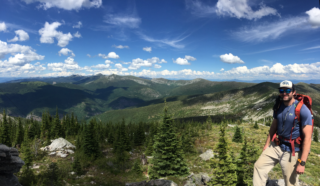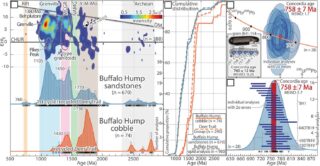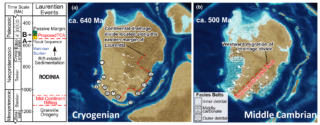Sandstones record ancient supercontinent processes

Research findings, led by PhD student Daniel Brennan and recently published in the journals Geology and Terra Nova, have given new insights into the break up of the supercontinent Rodinia and how it affected ancient sedimentary transport systems.
Brennan, together with supervisor John Curtin Distinguished Professor Zheng-Xiang Li, and additional collaborators from the John de Laeter Research Center at Curtin University and several universities in the United States, used a novel application of Laser-Ablation Inductively Coupled Mass Spectrometry to rapidly analyze almost 2000 individual zircon grains in order to determine the provenance of the studied rocks. The zircon grains were isolated from a stratigraphic sequence in the northwestern United States which was originally located right on the edge of the ancient North American continent. This region occupies a critical location, near the inferred center of supercontinent Rodinia, and the stratigraphy it contains are suggested correlatives to similar-age strata in southeastern Australia, or perhaps south China. In part, the similarity between these rocks led prior geologists to suggest that either Australia or South China was adjacent to western North American about 1 billion years ago within Rodinia.
However, the results by Brennan and colleagues showed that instead of being ~1 billion years old as previously thought, this package of North American sedimentary rocks (which includes a unit called the Buffalo Hump Formation) were actually approximately 250 million years younger, as they contained zircon mineral grains originally eroded from rocks as young as 760 million-years. The other ages and composition of mineral grains within the younger than expected sandstones suggested that some of the sediment was primarily sourced from terranes such as the Grenville Orogen, located hundreds of kilometers away in eastern/southeastern North America. These far traveled sand grains likely record huge “transcontinental” river systems that extended thousands of kilometers across ancient North America and supercontinent Rodinia. While other large cobbles within conglomeratic channels of the Buffalo Hump Formation were sourced from the underlying rocks (called the Deer Trail Group), suggesting nearby faulting and exhumation. This indicated that similar-age non-North American sources that are closer to the region within various paleogeographic supercontinent reconstructions of Rodinia were likely not major sources of sediment, and that the onset of Rodinia rift-related faulting in this region occurred after ca. 760 Ma.

Interestingly, these ca. 760-million-year-old sandstones are overlain by approximately 720-540 million years old sedimentary rocks that have correlative units along the entire western region of North America and record the opening of an ancient paleo-Pacific Ocean. Within these overlying sedimentary layers, similar far traveled zircon grains from eastern/southeastern North America are also recognized. In each of these packages of Neoproterozoic–Cambrian sedimentary rocks a shift from distal sources, to more proximal (or nearby) sources was recognized by prior workers. However, a tectonic mechanism to explain this provenance shift lacked a good explanation. Brennan and colleagues suggested that this shift in sources reflected the breakup of Rodinia not along the western margin of North America associated with the opening of a “paleo-Pacific” Ocean, but instead along the opposite eastern margin of North America, associated with the opening of a “paleo-Atlantic” Ocean called the Iapetus Ocean. Brennan suggested that as the Iapetus Ocean opened, the once topographically elevated region of eastern North America subsided and the “Transcontinental rivers” within Rodinia were cut off.

As often occurs with science, when the data answers a few questions, it also raises several more. While the research of Brennan and his team constrained the age of this package of rocks in western North America and offers an explanation for the recognized shift in sources for the overlying sedimentary units, it also indicated that this sequence of rocks are perhaps not as clear of a match for similar rocks in Australia or South China, as previously suggested. Thus, these rocks in North America, and their proposed correlatives in Australia, China, or elsewhere may still be hiding some clues as to exactly how the ancient supercontinent Rodina was configured and by what processes it broke apart.
Contact person: Mr Daniel Brennan, Earth Dynamics Research Group, Curtin University.
Relevant publications:
Brennan, D.T., Li, Z., Rankenburg, K., Evans, N., Link, P.K., Nordsvan, A.R., Kirkland, C.L., Mahoney, J.B., Johnson, T., and Mcdonald, B.J., 2021a. Recalibrating Rodinian rifting in the northwestern United States: Geology, 49(6): 617–622. https://doi.org/10.1130/G48435.1
Brennan, D.T., Mitchell, R.N., Spencer, C.J., Murphy, J.B., and Li, Z., 2021a. A tectonic model for the Transcontinental Arch: Progressive migration of a Laurentian drainage divide during the Neoproterozoic‐Cambrian Sauk Transgression. Terra Nova, 33(4), 430-440. https://doi.org/10.1111/ter.12528
